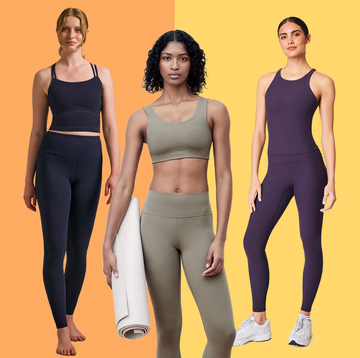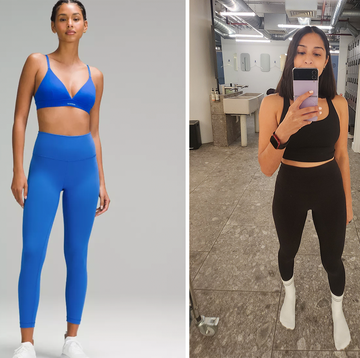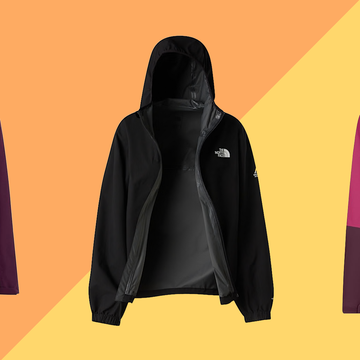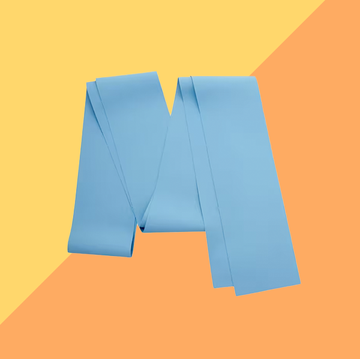We earn a commission for products purchased through some links in this article.
The best yoga blocks to improve balance and flexibility
Improve your flexibility with our editors’ top picks

Whether you’re a beginner in the yoga game, or you know your pigeon pose from your downward dog, the best yoga blocks will help you move more easily between poses, whatever your level.
They can help deepen a pose, bring the ground closer (handy when you’re trying to touch your toes), and allow you to hold poses for longer – particularly useful if you're a newbie.
Different sizes and shapes can suit particular poses and activities, so we’ve done a deep dive into their benefits and rounded up the best yoga blocks to add to your home workout kit or gym bag alongside your favourite yoga mat and leggings.
Here are our editors’ top picks at a glance but scroll on for our in-depth reviews.
What is a yoga block?
A yoga block is a piece of equipment designed to provide support, balance and stability as you work through different yoga or Pilates poses. They are typically rectangular blocks made from material such as cork or foam.
“These props can hugely enhance both the physical depth and lift of a posture, while greatly benefitting your experience,” explains Scarlett Woodford, a yoga teacher at MoreYoga.
“Blocks and other props are seen as only being suitable for beginners, and while that may be true for some, they really can benefit practitioners at any level,” she adds.
What are the benefits of using a yoga block?
Not sure if it's worth it? Here are some of the key benefits of popping a yoga block in your gym bag.
Increased height – by adding height and bringing the ground closer, a block will help make some poses easier if your flexibility isn’t quite there yet.
Increased strength – through the additional support of a yoga block, you can ensure your muscles are correctly aligned, with the right amount of tension, which will help to increase overall strength in those muscles over time.
Increased support – these props are designed to take your weight and support you where needed through poses. For example, if you find yourself shuddering like a fully loaded washing machine towards the end of your 30 second plank, a yoga block can help take the excess strain off your shoulders.
Increased mobility – thanks to the added height and support these blocks offer, you should be able to get into a deeper stretch, and therefore increase overall mobility. You can further add to this by incorporating a resistance band – another handy piece of home gym equipment that's easily transportable.
“Blocks can help us build strength in chaturangas (the ‘flow’ part of vinyasa and power yoga sequences), which is where I see a lot of students feeling a bit lost,“ explains. Woodford. “By simply placing a block under the chest, you can lower down from a plank slowly to build up that tricep strength and help your sequence feel stronger and more seamless over time.”
How do I use a yoga block?
Yoga blocks are commonly placed on the floor or yoga mat to help support your hands, feet, back or legs during different moves.
“Blocks typically have three levels (low, medium and high, which means people can experiment on their mat with what feels best. "They can also have less traditional uses,” says Woodford. “I’ve seen them placed under the hands in downward dog to offer relief to the wrists, and I’ve even seen them balanced on people’s heads while seated to help with posture during meditation!”
How to choose a yoga block
While simple exercise tools, it's worth considering what material you'd prefer and which size is best for you. Here's what to think about before you buy.
Material
These are the three main materials to choose from and their benefits.
- Foam: This is a great lightweight option for throwing into your gym bag, while still supporting your poses effectively. It’s slightly softer on your hands too, so it's good for beginners. However, as it's man-made, it's less sustainable than cork.
- Cork: Due to its higher density and sturdiness, cork is particularly supportive. This makes it a better option for standing or balancing poses. It's also the more sustainable choice as cork is a rapidly renewable and recyclable material. However, it is porous so can absorb sweat, and it's trickier to clean than foam or wood.
- Wood: This is the sturdiest option out there, but it's heavy, so better for using at home than taking to your workout class.
Size
Yoga blocks are available in small, medium and large sizes, and which one you opt for depends on what feels most comfortable for you. The size of your hands and flexibility level will determine how big you need to go.
If you have small hands, you may prefer a small or medium block. This will also suit you if you're relatively flexible. But if you aren't as confident or flexible, opt for something bigger.
Madeleine is our Lifestyle Writer, specialising in expert-tested reviews and round-ups on the latest beauty Beauty and Health & Wellness products. From skincare to protein powders, Maddie is committed to providing honest and helpful reviews to help guide readers to the best product for them. Maddie has a BA in English Literature and Language, which stemmed from her lifelong interest in reading and writing. She started her post graduate life at Hearst UK within a marketing capacity, which quickly turned into a desire to fulfil a writing career.
When she is not writing about the latest expert reviewed products, you can find her rifling through vintage shops or car boots, reading a print magazine, or capturing portraits on her film camera.


The best hiking backpacks, according to walkers

Best running vests for hydration and storage

16 best squat-proof gym leggings, tested

These earbuds could save you from sleep divorce

















